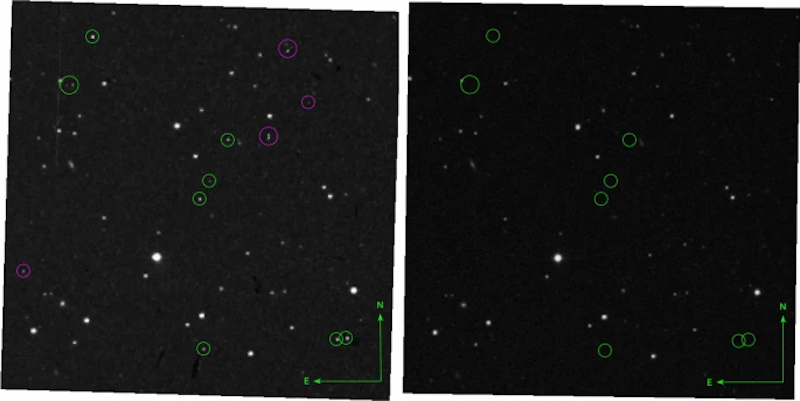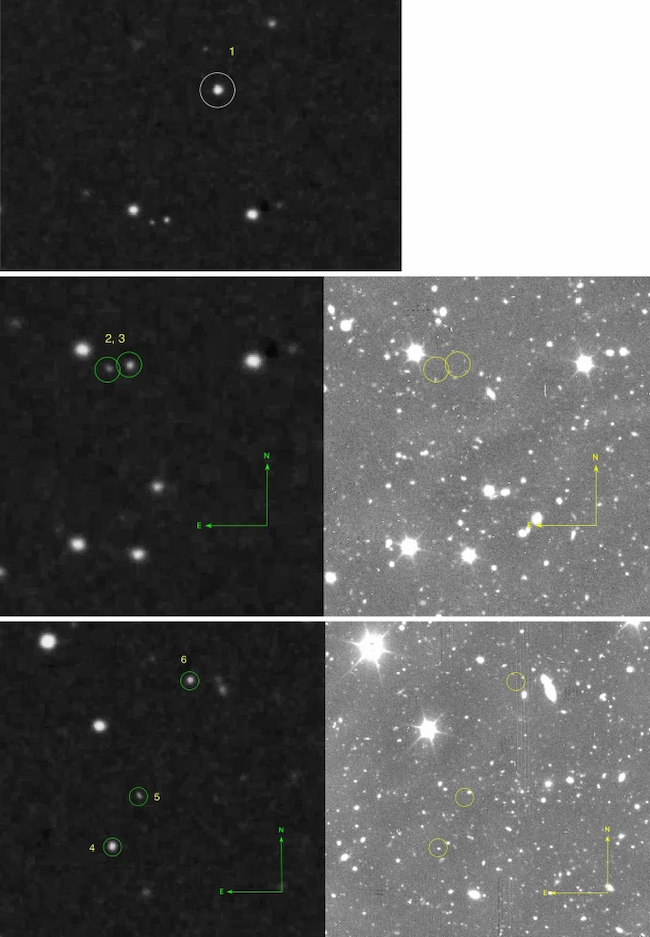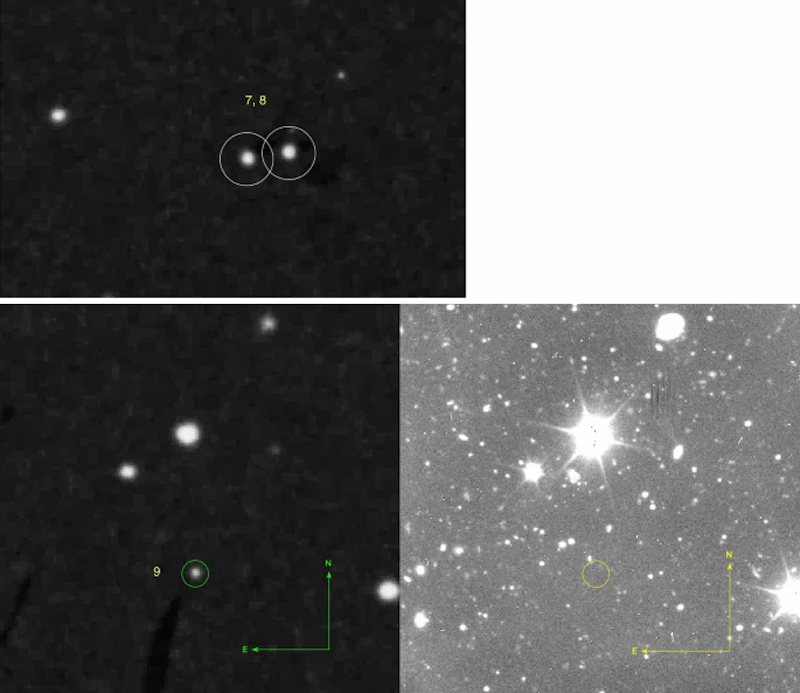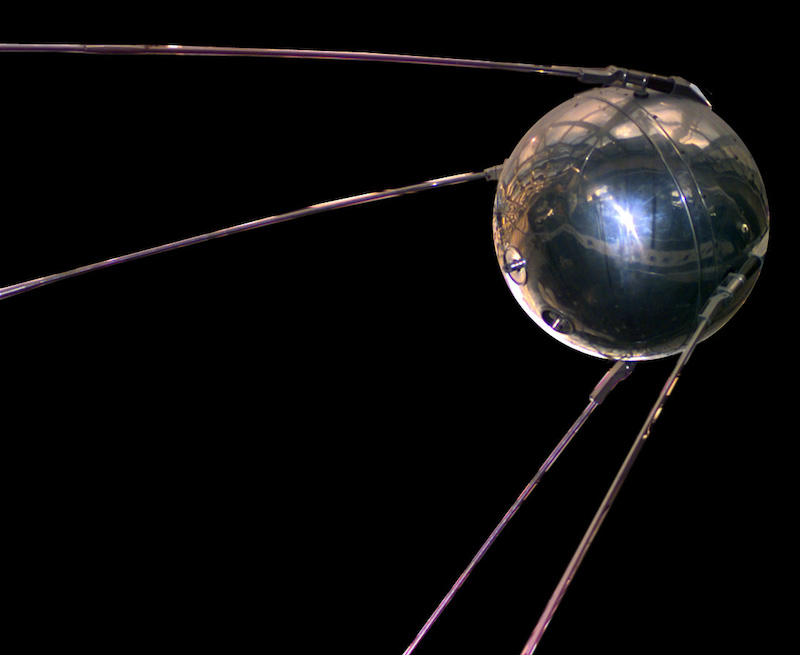
Do you love a good mystery? Then you’ll probably like this one. Something odd happened back in 1950, when astronomers noticed that nine starlike point sources of light had simultaneously appeared in a photographic plate acquired at the Palomar Observatory in Southern California as part of the famous Palomar Sky Survey. That might or might not sound unusual. But … none of those point sources were seen in images taken just before, of the same small patch of sky. Likewise, they didn’t appear in images taken after, either. That remains true through today, even with images from current surveys that are much more sensitive to faint objects. So what were these nine weird transients?
That’s the question addressed by Beatriz Villarroel at the Nordic Institute for Theoretical Physics in Stockholm, Sweden, and colleagues in a new paper. The peer-reviewed journal Scientific Reports – a publication of the prestigious journal Nature – published the paper on June 17, 2021.
The 9 weird transients: Here and gone
Beatriz Villarroel conducts a citizen science project called VASCO (Vanishing and Appearing Sources during a Century of Observations). The project searches for exotic or rare transients. The VASCO project has probed a time baseline of 70 years, using data from the United States Naval Observatory Catalog. So far, citizen scientists and professional astronomers working via VASCO have found about 100 transient objects, mostly on Palomar Sky Survey red plates. For her work on this project, Villarroel was recently awarded the L’Oréal-Unesco For Women in Science Prize in Sweden. The prize goes to:
… promising women at the beginning of their research careers in science, technology and mathematics and create role models for future generations.
Villarroel and her team point out that astronomers have seen stars (even an exoplanet) that seemed to “vanish” before this. For example, there are variable stars, whose brightness waxes and wanes. There are supernovae, asteroids and variable active galactic nuclei. All of these can change their brightness on timescales ranging from minutes to years.
But the nine point sources of light found in a red-sensitive Palomar Sky Survey plate – captured on April 12, 1950 – are different. All nine sources were absent in all of the images taken before or after. Astronomers didn’t find the “objects” – if we may call them objects – in a blue-sensitive photographic plate from 30 minutes earlier. They didn’t see them on a red-sensitive plate taken six days later. Whatever they were, the weird transients were unusual in being so numerous (nine of them!) and so fleeting in nature. Now you see them, now you never see them again? That’s very odd. The red plate from the 1950 Palomar Sky Survey reached down to a magnitude of about +20, vastly fainter than the human eye can see. The nine objects haven’t shown up in more modern photographic surveys, either, which are more sensitive to faint objects.
So were these nine “new” transients natural astronomical phenomena? Or were they something different?

In the instruments, not the sky?
If you’ve been thinking the “transients” might be akin to lens flares on modern photographs, you’re not alone. In the 1950 Palomar Sky Survey, the glass cover used during scanning could produce false stars in the image. But – according to the new paper by Villarroel and colleagues – the objects in the photographic plate image don’t have the shape expected from such ghost images. If the observers had exposed the same plate twice, with a partially or completely open shutter, then there should have been such artifacts all over the plate, not just nine.
Radioactive or other particles?
What about elementary particles? The researchers ruled out muons and natural radioactivity, since those particles hit the photographic plates at a steady rate. That does not fit with a few plates having extra stars. Had muons and natural radioactivity caused extra stars, then the photographic plates should be full of them.
Alpha particles, beta particles or gamma rays can leave traces on photographic plates. They could even appear “starlike.” There’s a problem with that theory, too, though. When the first atomic bomb detonated in Alamogordo, New Mexico, in July 1945 (the infamous Trinity Test), the radioactive contaminants left tiny fogged spots on photographic plates. But after that incident, new containers were created by Kodak to protect photographic plates from radioactive contamination.
It’s possible some plates might still have been contaminated at Mount Palomar, but probably not likely, according to Villarroel and her team. Also, no official atomic bomb tests were carried out between 1949 and 1951, around the time of the transients discovery.

A more human cause?
The researchers considered events in the observatory itself that might cause this kind of anomaly. Humidity could leave traces on photographic plates, or even tiny droplets from hay fever (sneezing) or saliva. But sprayed microdroplets of saliva, peaking around 100 microns in size, do not produce circular shapes on a flat surface, Rather, they are elongated, wobbly and clustered driplets.
Water droplets also have a broader range of sizes than what appears on the plates.
It’s possible that the point sources were some other kind of contamination or degradation. The researchers noted that some very faint transients can occur in contaminated regions of the plates. These could be from the glass cover used during the plate scanning process. The more luminous transients among the simultaneous transients are more difficult to reconcile with the hypothesis of contamination, however. To fully exclude the possibility of this kind of contamination, the plates would need to be examined under a microscope. The researchers, however, don’t have access to the original plates.
Naturally occurring transients?
If not contamination, could the cause be some kind of naturally occurring transients already known about? That seems unlikely, the researchers said. The total density of naturally occurring fast transients such as flaring stars, gamma-ray bursts or fast radio bursts is estimated to be about 1.63 events per square degree per day, up to a limiting magnitude of 23 or 24.7. Also, the Vera C. Rubin Observatory expects to find 100,000 short-lived transients per day, which corresponds to about 2.5 events per square degree per day.
In this case though, there were nine simultaneous transients within a 30-minute period, within a box on the sky’s dome 10×10 arcminutes square (there are 60 arcminutes in 1 degree; so, for example, the moon and sun are each half a degree or 30 arcminutes across). The researchers conclude that this kind of transient doesn’t explain the phenomenon.
The astronomers also considered a cluster of high-redshift galaxies, but noted in their paper:
A cluster of high redshift galaxies cannot explain the nine simultaneous transients because they should continue to flash after the 1950s, which they do not.

Fragmenting asteroids or meteoroids?
The researchers consider asteroids or meteoroids unlikely, since any such fragments would be moving in space. They’d have moved significantly during the 50-minute exposure time for the photographic plate. And so asteroids or meteoroids would have left long streaks in the image, which they didn’t. The parent body for any fragments should also have been visible in the blue-sensitive plates from 30 minutes earlier, but nothing showed up.
What about meteoroid fragments burning up in Earth’s atmosphere? If they glinted in the sunlight, could that be the answer? In order to appear as a point source, the burning process would need to last less than a fraction of a millisecond. Otherwise, they too will look like elongated streaks in the images. The researchers found that such events would be too faint to show up on the photographic plates, which had a magnitude limit of about +20 magnitude. The timescale was also inconsistent, so the researchers ruled out asteroids, meteoroids or similar objects.
Airplanes or satellites?
Could the explanation be a bit closer to home, as in airplanes or satellites? Airplane strobes can flash quickly, as in short transient bursts. But airplanes also have lights that are continuous and do not strobe. Those would have left streaks in the image as well.
Interestingly, rotating satellites or debris in geosynchronous orbits can produce similar point sources like those seen in 1950. But there is one big problem with that scenario. That is, the first satellite, Sputnik 1, wasn’t launched until 1957.
A process of elimination
As of now, it seems that out of the possibilities mentioned, satellites would be the closest match. Yet this happened a full seven years before the launch of the first satellite. From the paper:
A follow-up critique showed that the … transient is more likely explained by a solar system satellite of artificial or natural origin. Small, flat and highly reflective objects at, or near, geosynchronous orbits around the Earth could produce multiple, fast glints.
The only other possibility still under consideration at this point is some kind of unknown contamination of the plates. From the paper:
In comparison to this, one may find the first proposed scenario with radioactive bomb particles more down-to-Earth. As this case of simultaneous transients is not unique, contamination cannot be excluded as an explanation.

Hear Beatriz Villarroel speak about the 9 weird transients
If you’re interested in learning more, there is an excellent interview with lead author Villarroel on the July 16, 2021, Wow! Signal Podcast. At the end, she notes that the nine transients from 1950 might be a good test case for solar system SETI, which involves the search for extraterrestrial probes.
Whatever the explanation is, this is certainly an intriguing mystery, as the researchers noted:
We believe the mystery of the simultaneous transients is a detective story worth of the attention of the astronomical community.
Bottom line: Astronomers in Sweden are trying to solve the mystery of the nine weird transients that were seen in a photographic plate taken at the Palomar Observatory in 1950. They were never seen before, and have not been seen again since.
Source: Exploring nine simultaneously occurring transients on April 12th 1950











